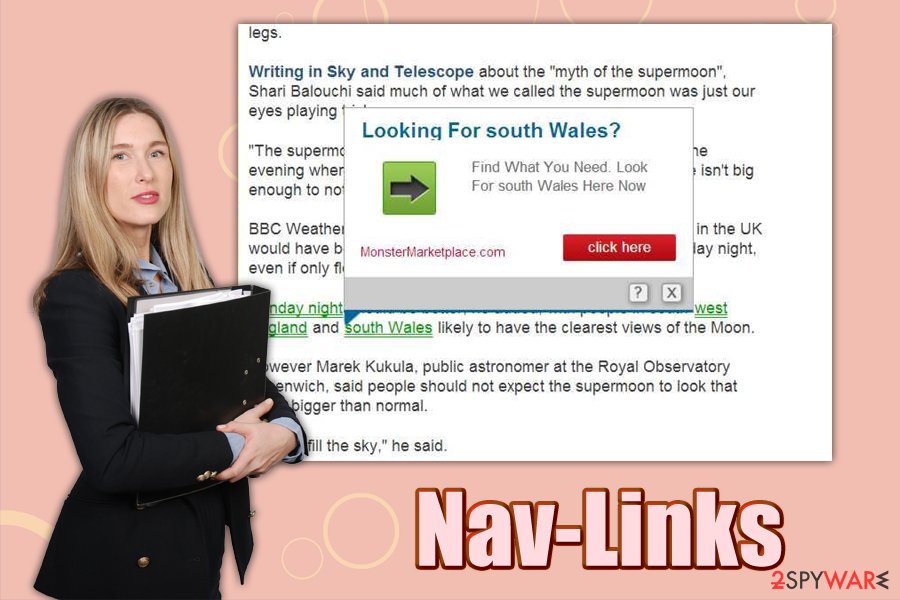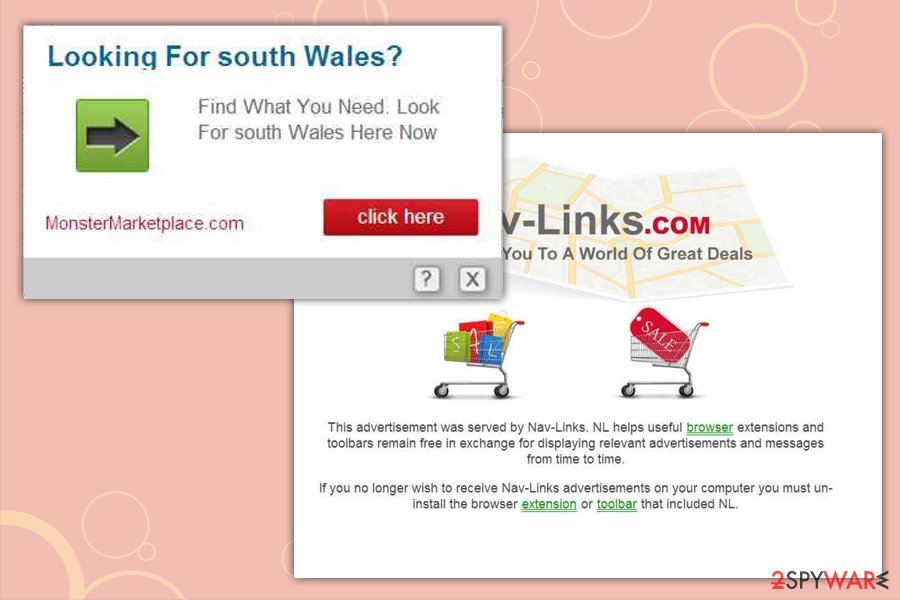Nav-Links (Virus Removal Guide) - updated Oct 2019
Nav-Links Removal Guide
What is Nav-Links?
Nav-Links is an adware application that offers various deals but also infuses web browsers with intrusive ads

Nav-Links is an advertising platform that is often misused by potentially unwanted programs, namely, adware.[1] Unwanted applications often infest users' machines after the installation of freeware/shareware from third-party sites, as the optional component, which is actually a PUP, is hidden within Advanced settings of the installation wizard. Therefore, the infiltration of Nav-Links is rarely noticed by users, although they will soon start seeing pop-ups, coupons, deals, offers, discounts, and other commercial content on their browsers.
While Nav-Links adware specializes in such schemes as pay-per-click, pay-per-install,[2] and targeted advertisement, some unsafe apps may redirect users to scam, tech support, or even malware-laden sites. Besides, while infected, they are more prone to install other potentially unwanted programs that alter the settings of Google Chrome, Mozilla Firefox, or Internet Explorer to introduce more adverts on all sites users visit.
| Name | Nav-Links |
| Related | Intext.nav-links.com, Nav-Links.com, Plus HD, Button for Google Drive, Button for LinkedIn |
| Type | Adware, potentially unwanted program |
| Affected browsers | Unwanted programs mainly target Google Chrome, Internet Explorer and Mozilla Firefox browsers |
| Infiltration | In most cases, users get infected with adware or other potentially unwanted programs when introducing freeware or shareware apps to the system, due to the so-called software bundling technique. Alternatively, users may install adware after being tricked by a fake ad or an attractive offer |
| Potential dangers | Users are more likely to install other potentially unwanted programs during web browsing that might pose a threat to computer security; additionally, they can also be redirected to scam sites that urge to call fake PC repair technicians, consequently losing their money for fake support services |
| Symptoms | Symptoms may vary, but most common ones include:
|
| Termination | To stop the unwanted activities on their browsers, users need to get rid of adware extension or a program – the instructions for the process are presented at the bottom of this post |
| Recovery | We highly recommend using complementary software to your anti-virus – FortectIntego. By using it, you can recover from any malware or PUP infection in just a few seconds |
Once infected with the Nav-Links virus, users may experience strange browser behavior, and the signs of the infection are the only reason users start becoming more aware that their computers are affected by a PUP. In some cases, users might start seeing advertisement banners and other ads that are marked as follows:
- Nav-Links ads
- Powered by Nav-Links
- Brought to you by Nav-Links
- Ads by Nav-Links, etc.
Nevertheless, Nav-Links ads are usually unmarked, and users might sometimes think that they are embedded within the website that they are visiting. However, in reality, the ad content is a virtual layer that is placed on the browsers regardless of which sites are visited.

Most of the commercial content that users encounter usually lead them to affiliated sites that are completely safe to use (for example, eBay), although some of Nav-Links ads might be unsafe. Users might occasionally be redirected several times and the final destination will be a tech support scam, spoofing, or even malware-filled site. Thus, it is vital not to interact with such content, as it is easily possible to infect your machine with rootkit,[3] trojan, cryptojacker, or other malicious software.
Nav-Links removal should not cause much troubles to you, especially if ads and redirects are caused by a browser extension – check out the guide below. You should also reset all the installed browsers and scan your machine with FortectIntego for best results.
Do not rush through the installation process of new programs and don't get tricked by attractive offers or fake updates
Quite often, users are careless when it comes to computer safety and, while most already known about obvious hazards like pirated software downloads, they are still unaware of other threats that might be lurking on third-party sites. Most of the time, users infect their machines with potentially unwanted programs due to the hasty installation of freeware obtained from third-party sites. For example, clicking the “Next” button until the installation is finished is very common, and most users are guilty of not picking Advanced/Custom installation settings.
On its own, software bundling is not evil – offering to try out software to users is a good thing. However, the problems behind when optional apps are deliberately berried within the installer, and users struggle to notice all the deals in the first place. Offers should be presented clearly, without trying to mislead end users. Unfortunately, many unfair software distributors and developers still abuse the fact that users are careless, and infect their machines with adware or even malware.
Thus, be attentive while navigating through the internet – read up on the app online before installing it. Also, be aware that fake Flash updates or bogus virus alerts are often used to propagate PUPs. Finally, install security software that is capable of stopping unwanted apps before they manage to enter.

Get rid of Nav-Links ads
Adware, while not considered as serious computer infection, should not be ignored, as its prolonged prescience may result in other PUP or even malware infections. Therefore, Nav-Links removal should not be delayed. For that, you should follow the instructions we provide below for Windows and Mac operating systems. Be aware that there might be multiple PUPs installed on your system, so you have to make sure that all of them are terminated.
If you do not want to waste your time, you can also remove Nav-Links using anti-malware software that specializes in PUP detection. This way, all the unwanted components will be terminated automatically in just a few seconds.
Regardless of which way you pick for potentially unwanted program termination, you should also reset all the installed browsers, or Nav-Links ads might show up repeatedly.
You may remove virus damage with a help of FortectIntego. SpyHunter 5Combo Cleaner and Malwarebytes are recommended to detect potentially unwanted programs and viruses with all their files and registry entries that are related to them.
Getting rid of Nav-Links. Follow these steps
Uninstall from Windows
To remove Nav-Links from your Windows computer, access Programs and Features section via the COntrol Panel:
Instructions for Windows 10/8 machines:
- Enter Control Panel into Windows search box and hit Enter or click on the search result.
- Under Programs, select Uninstall a program.

- From the list, find the entry of the suspicious program.
- Right-click on the application and select Uninstall.
- If User Account Control shows up, click Yes.
- Wait till uninstallation process is complete and click OK.

If you are Windows 7/XP user, proceed with the following instructions:
- Click on Windows Start > Control Panel located on the right pane (if you are Windows XP user, click on Add/Remove Programs).
- In Control Panel, select Programs > Uninstall a program.

- Pick the unwanted application by clicking on it once.
- At the top, click Uninstall/Change.
- In the confirmation prompt, pick Yes.
- Click OK once the removal process is finished.
Delete from macOS
Macs often suffer from adware infections. Check for potentially unwanted applications and terminate them as explained below:
Remove items from Applications folder:
- From the menu bar, select Go > Applications.
- In the Applications folder, look for all related entries.
- Click on the app and drag it to Trash (or right-click and pick Move to Trash)

To fully remove an unwanted app, you need to access Application Support, LaunchAgents, and LaunchDaemons folders and delete relevant files:
- Select Go > Go to Folder.
- Enter /Library/Application Support and click Go or press Enter.
- In the Application Support folder, look for any dubious entries and then delete them.
- Now enter /Library/LaunchAgents and /Library/LaunchDaemons folders the same way and terminate all the related .plist files.

Remove from Microsoft Edge
Delete unwanted extensions from MS Edge:
- Select Menu (three horizontal dots at the top-right of the browser window) and pick Extensions.
- From the list, pick the extension and click on the Gear icon.
- Click on Uninstall at the bottom.

Clear cookies and other browser data:
- Click on the Menu (three horizontal dots at the top-right of the browser window) and select Privacy & security.
- Under Clear browsing data, pick Choose what to clear.
- Select everything (apart from passwords, although you might want to include Media licenses as well, if applicable) and click on Clear.

Restore new tab and homepage settings:
- Click the menu icon and choose Settings.
- Then find On startup section.
- Click Disable if you found any suspicious domain.
Reset MS Edge if the above steps did not work:
- Press on Ctrl + Shift + Esc to open Task Manager.
- Click on More details arrow at the bottom of the window.
- Select Details tab.
- Now scroll down and locate every entry with Microsoft Edge name in it. Right-click on each of them and select End Task to stop MS Edge from running.

If this solution failed to help you, you need to use an advanced Edge reset method. Note that you need to backup your data before proceeding.
- Find the following folder on your computer: C:\\Users\\%username%\\AppData\\Local\\Packages\\Microsoft.MicrosoftEdge_8wekyb3d8bbwe.
- Press Ctrl + A on your keyboard to select all folders.
- Right-click on them and pick Delete

- Now right-click on the Start button and pick Windows PowerShell (Admin).
- When the new window opens, copy and paste the following command, and then press Enter:
Get-AppXPackage -AllUsers -Name Microsoft.MicrosoftEdge | Foreach {Add-AppxPackage -DisableDevelopmentMode -Register “$($_.InstallLocation)\\AppXManifest.xml” -Verbose

Instructions for Chromium-based Edge
Delete extensions from MS Edge (Chromium):
- Open Edge and click select Settings > Extensions.
- Delete unwanted extensions by clicking Remove.

Clear cache and site data:
- Click on Menu and go to Settings.
- Select Privacy, search and services.
- Under Clear browsing data, pick Choose what to clear.
- Under Time range, pick All time.
- Select Clear now.

Reset Chromium-based MS Edge:
- Click on Menu and select Settings.
- On the left side, pick Reset settings.
- Select Restore settings to their default values.
- Confirm with Reset.

Remove from Mozilla Firefox (FF)
Remove dangerous extensions:
- Open Mozilla Firefox browser and click on the Menu (three horizontal lines at the top-right of the window).
- Select Add-ons.
- In here, select unwanted plugin and click Remove.

Reset the homepage:
- Click three horizontal lines at the top right corner to open the menu.
- Choose Options.
- Under Home options, enter your preferred site that will open every time you newly open the Mozilla Firefox.
Clear cookies and site data:
- Click Menu and pick Settings.
- Go to Privacy & Security section.
- Scroll down to locate Cookies and Site Data.
- Click on Clear Data…
- Select Cookies and Site Data, as well as Cached Web Content and press Clear.

Reset Mozilla Firefox
If clearing the browser as explained above did not help, reset Mozilla Firefox:
- Open Mozilla Firefox browser and click the Menu.
- Go to Help and then choose Troubleshooting Information.

- Under Give Firefox a tune up section, click on Refresh Firefox…
- Once the pop-up shows up, confirm the action by pressing on Refresh Firefox.

Remove from Google Chrome
Reset Google Chrome following the PUP removal:
Delete malicious extensions from Google Chrome:
- Open Google Chrome, click on the Menu (three vertical dots at the top-right corner) and select More tools > Extensions.
- In the newly opened window, you will see all the installed extensions. Uninstall all the suspicious plugins that might be related to the unwanted program by clicking Remove.

Clear cache and web data from Chrome:
- Click on Menu and pick Settings.
- Under Privacy and security, select Clear browsing data.
- Select Browsing history, Cookies and other site data, as well as Cached images and files.
- Click Clear data.

Change your homepage:
- Click menu and choose Settings.
- Look for a suspicious site in the On startup section.
- Click on Open a specific or set of pages and click on three dots to find the Remove option.
Reset Google Chrome:
If the previous methods did not help you, reset Google Chrome to eliminate all the unwanted components:
- Click on Menu and select Settings.
- In the Settings, scroll down and click Advanced.
- Scroll down and locate Reset and clean up section.
- Now click Restore settings to their original defaults.
- Confirm with Reset settings.

Delete from Safari
Remove unwanted extensions from Safari:
- Click Safari > Preferences…
- In the new window, pick Extensions.
- Select the unwanted extension and select Uninstall.

Clear cookies and other website data from Safari:
- Click Safari > Clear History…
- From the drop-down menu under Clear, pick all history.
- Confirm with Clear History.

Reset Safari if the above-mentioned steps did not help you:
- Click Safari > Preferences…
- Go to Advanced tab.
- Tick the Show Develop menu in menu bar.
- From the menu bar, click Develop, and then select Empty Caches.

After uninstalling this potentially unwanted program (PUP) and fixing each of your web browsers, we recommend you to scan your PC system with a reputable anti-spyware. This will help you to get rid of Nav-Links registry traces and will also identify related parasites or possible malware infections on your computer. For that you can use our top-rated malware remover: FortectIntego, SpyHunter 5Combo Cleaner or Malwarebytes.
How to prevent from getting adware
Stream videos without limitations, no matter where you are
There are multiple parties that could find out almost anything about you by checking your online activity. While this is highly unlikely, advertisers and tech companies are constantly tracking you online. The first step to privacy should be a secure browser that focuses on tracker reduction to a minimum.
Even if you employ a secure browser, you will not be able to access websites that are restricted due to local government laws or other reasons. In other words, you may not be able to stream Disney+ or US-based Netflix in some countries. To bypass these restrictions, you can employ a powerful Private Internet Access VPN, which provides dedicated servers for torrenting and streaming, not slowing you down in the process.
Data backups are important – recover your lost files
Ransomware is one of the biggest threats to personal data. Once it is executed on a machine, it launches a sophisticated encryption algorithm that locks all your files, although it does not destroy them. The most common misconception is that anti-malware software can return files to their previous states. This is not true, however, and data remains locked after the malicious payload is deleted.
While regular data backups are the only secure method to recover your files after a ransomware attack, tools such as Data Recovery Pro can also be effective and restore at least some of your lost data.
- ^ Adware. Wikipedia. A free encyclopedia.
- ^ Kevin Stevens. The Underground Economy of the Pay-Per-Install (PPI) Business . Blackhat. Presentation.
- ^ Dan Rafter. What is a rootkit? And how to stop them. Norton. Security blog.























